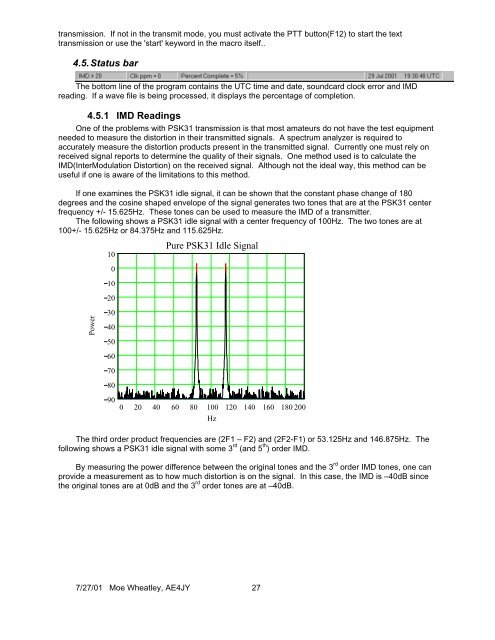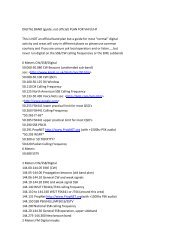Create successful ePaper yourself
Turn your PDF publications into a flip-book with our unique Google optimized e-Paper software.
transmission. If not in the transmit mode, you must activate the PTT button(F12) to start the text<br />
transmission or use the 'start' keyword in the macro itself..<br />
4.5. Status bar<br />
The bottom line of the program contains the UTC time and date, soundcard clock error and IMD<br />
reading. If a wave file is being processed, it displays the percentage of completion.<br />
4.5.1 IMD Readings<br />
One of the problems with <strong>PSK</strong>31 transmission is that most amateurs do not have the test equipment<br />
needed to measure the distortion in their transmitted signals. A spectrum analyzer is required to<br />
accurately measure the distortion products present in the transmitted signal. Currently one must rely on<br />
received signal reports to determine the quality of their signals. One method used is to calculate the<br />
IMD(InterModulation Distortion) on the received signal. Although not the ideal way, this method can be<br />
useful if one is aware of the limitations to this method.<br />
If one examines the <strong>PSK</strong>31 idle signal, it can be shown that the constant phase change of 180<br />
degrees and the cosine shaped envelope of the signal generates two tones that are at the <strong>PSK</strong>31 center<br />
frequency +/- 15.625Hz. These tones can be used to measure the IMD of a transmitter.<br />
The following shows a <strong>PSK</strong>31 idle signal with a center frequency of 100Hz. The two tones are at<br />
100+/- 15.625Hz or 84.375Hz and 115.625Hz.<br />
Power<br />
10<br />
0<br />
10<br />
20<br />
30<br />
40<br />
50<br />
60<br />
70<br />
80<br />
Pure <strong>PSK</strong>31 Idle Signal<br />
90<br />
0 20 40 60 80 100<br />
Hz<br />
120 140 160 180 200<br />
The third order product frequencies are (2F1 – F2) and (2F2-F1) or 53.125Hz and 146.875Hz. The<br />
following shows a <strong>PSK</strong>31 idle signal with some 3 rd (and 5 th ) order IMD.<br />
By measuring the power difference between the original tones and the 3 rd order IMD tones, one can<br />
provide a measurement as to how much distortion is on the signal. In this case, the IMD is –40dB since<br />
the original tones are at 0dB and the 3 rd order tones are at –40dB.<br />
7/27/01 Moe Wheatley, AE4JY 27



